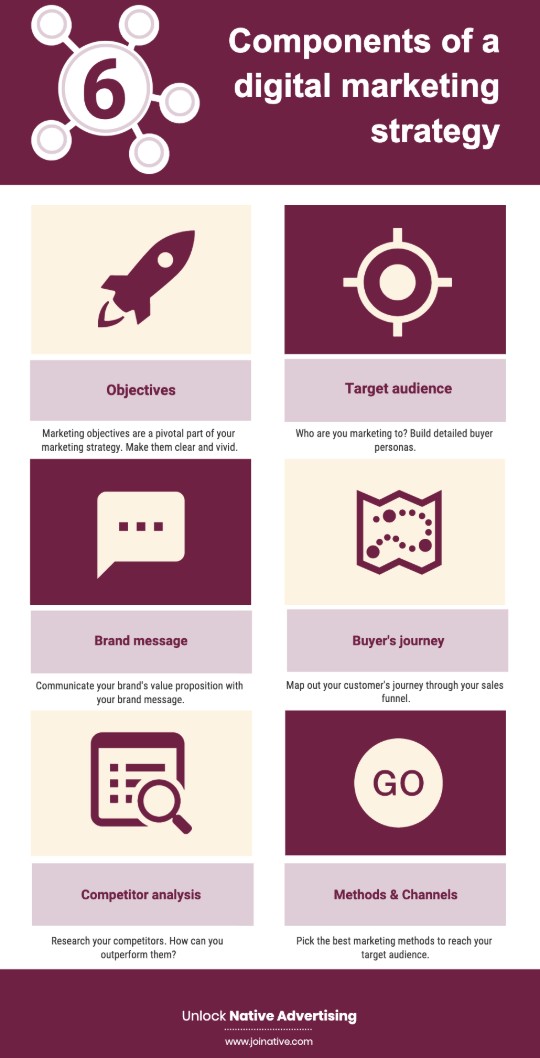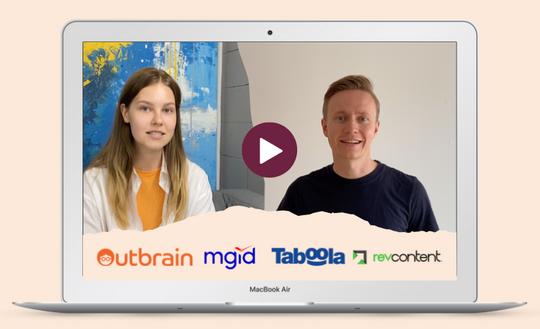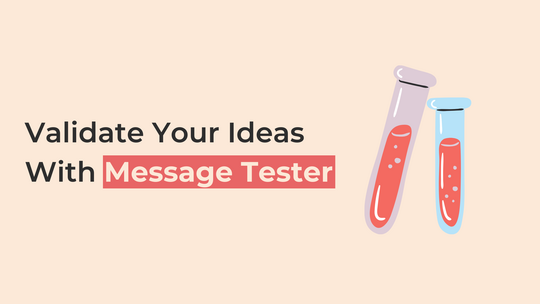
Top 6 Components of a Strong Digital Marketing Strategy
So you need to promote your brand. Where should you start? Should you develop a content marketing plan or go with a cold email campaign first? None of the above, actually.
A successful marketing campaign starts with a well-thought marketing strategy. Surprisingly, more than half of the brands surveyed either don’t have a clearly defined digital marketing strategy or haven’t integrated it yet. While it’s possible a few campaigns eventually succeed, missing the strategy is making your marketing less effective.
Your online marketing strategy will help you significantly on your way to reaching your business goals. To define the most effective marketing methods, understand your customers and reach them, you need a solid strategy. Good news: developing your own strategy is not rocket science, and we’re here to guide you through it.
In this article, we describe the difference between a marketing strategy and a marketing plan and highlight the following six essential components of a digital marketing strategy:
- Objectives
- Target audience
- Brand message
- Buyer’s journey
- Competitor analysis
- Methods & Channels
Let’s see what we’ve got.
What exactly is a marketing strategy?
Let’s start with the definition of a marketing strategy itself. According to Investopedia, it’s:
‘… a business’s overall game plan for reaching prospective consumers and turning them into customers of the products or services the business provides.’
A solid marketing strategy is drawn from proper market research, defining the business’s value proposition and key brand messaging.
What’s the difference between a marketing strategy and a marketing plan?
You might have noticed an intersection between these two terms. Though a marketing plan would be impossible without a marketing strategy, they have quite different meanings.
When you start building a digital marketing strategy, you need to first explain the goals you want to achieve with your marketing efforts. You define what you want to achieve, then you describe who you want to reach, and finally claim what you want to sell. A marketing strategy always implies a long-term approach, as it’s considered to be a foundation for your marketing initiatives.
Talking about a marketing plan, we refer to the marketing activities you conduct during specific campaigns. With your marketing plan, you define how you’re going to reach the goals you set when determining your marketing strategy.
If you want to build a house, you’ll need to find the land and have at least an overall idea of what it should be before an architect starts creating a plan, right?
What are the essential components of a marketing strategy?
Now that we’ve defined the basics of digital strategy, let’s discover what action points you should consider when developing your own one.

Objectives & SMART goals
Whatever you start with, you need to answer the question: “What’s my objective?” This rule is especially relevant for all your marketing activities.
Begin with defining the core of your marketing strategy – long-term objectives. What do you want to reach in the next couple of years?
Here are several questions that will help you in defining your business goals
- How much market share do you want to capture?
- How much revenue do you expect to get?
- What’s the audience size you’re planning to reach?
Try to be specific when setting the objectives. While these long-term goals are broad enough, adding the numbers will help you measure your marketing performance effectively.
What are SMART goals?
Along with long-term objectives, it’s crucial that you set SMART goals and tie them into your marketing objectives. What does it mean?
According to the most common definition, SMART stands for specific, measurable, achievable, relevant, and time-bound.
As you won’t reach your overall business objectives soon after you set them, your SMART goals will be the stepping stones you’ll need to complete to achieve your initial objectives.
For instance, if your long-term objective is to double size your audience within 2 years, your SMART objectives might be the following:
- Launch Twitter chats with niche experts and gain +1,000 followers by the end of the quarter.
- Publish 5 survey-based studies (viral content) during the first year.
- Increase the blog’s organic traffic from email by 10% per month by the end of the first year.
Target audience
How can your product or service solve your customers’ problems? To answer this question you need to know your target customer first.
Lots of business owners make a common mistake thinking they know their audience well enough without the need to spend time conducting market research. With so many marketing approaches existing today, identifying your customers’ locations and age groups is not enough. To build an effective marketing strategy, you need to conduct in-depth research of your target market:
Step 1: Compile data on your current customers. Talk to your sales department, check website analytics, leverage your experience of communicating with clients, etc.
Step 2: Social media analytics. What are your audience’s demographics? Who are the most active users? Use social media analytics tools to discover who interacts with your social media accounts.
Step 3: Research your competition. Although you won’t be able to collect detailed data on your competitors’ customers and followers, you can discover which markets they’re targeting and whether their efforts are effective.
Step 4: Define your audience’s pain points. To make your statement appealing enough, you need to understand the problems your customers are trying to solve.
Step 5: Revisit your audience research regularly.
When you define your target market, turn your research into buyer personas.
Here’s how HubSpot defines a buyer persona:
A buyer persona is a semi-fictional representation of your ideal customer based on market research and real data about your existing customers.
In other words, a buyer persona is a fictional character created based on the key characteristics of your target audience.
Your buyer persona’s profile should be as detailed as possible and contain information that will later help you adjust your marketing campaigns. Different brands use different approaches to building the portrait of their ideal customer, but the following data is a must:
- Location
- Language
- Age group
- Gender
- Interests
- Job title
- Hierarchical position
- Education
- Income
- Relationship status
- Pain points
Ideally, you should develop several buyer personas to have a more clear understanding of different segments of your target audience.
On-Demand Video Course On Native Advertising
Boost your ROAS with native ads. Enroll now with our limited 30% discount.

Brand message
The way you present your unique selling proposition matters a lot. The brand message is one of the major elements of a marketing strategy. Your brand message is a reflection of the spirit of your company that might help you stand out and add value to your brand. With it, you should be able to highlight the benefits your brand offers and claim the thing that differentiates you from your competition.
If you manage to create a brand message that resonates, it may become one of the most crucial factors that will help you close sales rather than losing them.
People often confuse brand messaging and slogans, but these aren’t the same. While your slogan should correlate with your brand message, it’s a lot more than stringing a few words together and making them memorable. It’s rather a full messaging framework that will affect all your marketing activities and be present in every piece of content you produce. Everything you create, both internally and externally, should be able to map back to this messaging.
Buyer’s journey
Your company’s buyer’s journey is all the way your customer makes from experiencing symptoms of their problem to deciding it’s your brand that can help them address it. It’s essential to align your marketing efforts with the buyer’s journey to capture your prospects’ attention and stay relevant at every stage they might face your brand.
Below you can find three stages of the buyer’s journey defined:

To better understand what your company’s customer journey looks like, you’ll need to take a closer look at your buyer personas. Here are additional questions you’ll need to cover to put together the buyer’s journey for your company:
- How would you describe the problem that you could help your customers to address?
- How experienced are they when they start defining their problem?
- How could you educate them on the subject?
- Where do they usually go to find the solution?
- What sources do they trust the most in such cases?
- What are the most common options/alternatives they are most likely to find during their research?
When you answer these questions, you’ll be able to provide and optimize content that will be useful for your prospective customers at different stages of the buyer’s journey.
Competitor analysis
Regardless of what niche you’re entering, you’ll have competition, or at very least, alternatives. And this competition has been there for quite a long time and has already built some trust and authority. Now, it’s your turn to prove you can do better.
This is where competitor analysis comes in. It will help you figure out how your competitors acquire customers, learn their strengths and weaknesses, and find ways of standing out from the crowd.
While the comprehensive competitor analysis will take a more advanced approach, here are five steps you should start with:
- Identify your competition. It’s not enough to know several big brands in your niche. As you’re a newbie in the game, you’ll be competing with local and niche brands first.
- Check their websites. What do they offer? What is their value proposition? How do they communicate with their customers?
- Scan your competitors’ social media accounts. What differentiates their marketing campaigns? Search for mentions of your competitors online to find out what other people talk about them.
- Use competitor analysis tools. With platforms like SEMrush and Ahrefs, you can find out what your competitors are doing with their SEO. Which keywords generate the maximum traffic for your competitors? What keywords did they miss? Where do they get links? You can also go with SimilarWeb to get an idea of which channels your competitors use to reach their marketing goals.
- Check their top-performing content. Platforms like Buzzsumo let you track activity around your competitors’ content marketing efforts.
Marketing techniques & Channels
When the previous five key elements of a customer-driven marketing strategy are streamlined, you can proceed to select marketing tools and methods that will help you communicate your brand message to your target audience. And this is where your marketing plan begins.
As you already know your target audience and what they’re looking for, choosing the channels that will work shouldn’t be a problem.
Among the most effective digital marketing methods are:
- SEO, or search engine optimization, is the process of optimizing your website towards getting traffic from organic results on search engines. Do you want to rank high on Google? Go with SEO. It’ll take time to see results, but the game is worth the candle.
- SMM, or social media marketing, is the process of using social media channels to attract the audience’s attention.
- Content marketing is a marketing approach that focuses on creating and distributing content on a consistent basis to attract and retain the relevant audience.
- PPC, or pay-per-click, is an advertising model in which advertisers pay a fee each time users click on their ads. The ads can be displayed on websites, below search engine results or on social media channels.
- Native advertising is an online marketing method that involves using paid ads that match the look of the website they’re displayed on and fit seamlessly into the surrounding content.
- Email marketing is a way of promoting content to a group of people through email.
- Influencer marketing is a form of marketing that brings key industry leaders in the process of brand promotion.
Still, don’t rush into all the traditional marketing techniques at once. There’s no silver bullet when it comes to marketing. So, running a fancy Instagram account and staying active on Twitter won’t work for everyone. For instance, if you know your audience is interested in reading finance and business-related magazines, such as Business Insider, Nasdaq, or Reuters, you should definitely go with native advertising and promote your content on these websites. Native advertising is extremely beneficial for brands that prioritize generating high-value leads through meaningful and less disruptive engagements.
Most people these days find native ads to be more trustworthy and engaging than other traditional advertising methods. If you don’t know where to start, Joinative will help you. We offer full management and optimization of your native advertising campaigns. With Joinative, you’ll not only see how effective native advertising can be for you but will also learn how to drive these results yourself.

 Feed
Feed


